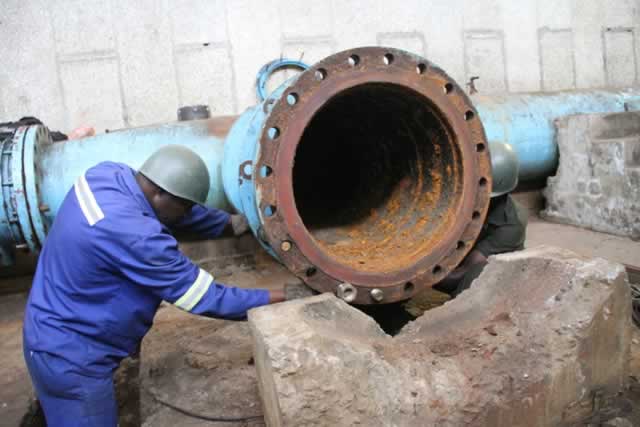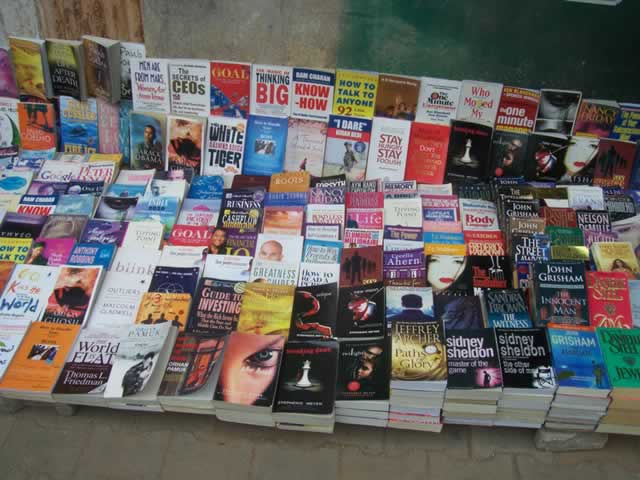Dry taps to become history


A Harare City worker examines one of the rusty pipes at Morton Jaffray Water Treatment Plant that will be replaced under the China EximBank US$144 million loan facility
Fortious Nhambura Senior Features Writer
THERE is a ray of hope for Harare.
If the movement in the Department of Water in Harare is anything to go by, then residents are likely to start experiencing the effects In the taps soon.
At last, real efforts to improve Harare’s water production and distribution have commenced.
Following years of bickering coupled with plans that never took off something is happening now.
On Sunday September 19 Chinese water engineers arrived in Zimbabwe to start work on rehabilitating Harare’s ailing water supply system.
The engineers will work with their counterparts in the Harare City Council.
The work is expected to increase the daily water production capacity at Morton Jaffray Waterworks from the current 450 megalitres to 640ml per day.
It is everyone’s hope that the action will see an increase in water availability in Harare’s suburbs and the surrounding local authorities that feed from the city’s water infrastructure.
Scuttled by an antiquated water pumping and piping infrastructure commissioned many years before Zimbabwe’s independence in 1980 and for a population of less than 350 000, mainly white residents, the system has been overstretched to cater for 2,5 million residents.
The city’s population continues to grow.
Administrative bungling at the urban authority contributed to their struggle to reliably and regularly supply clean water to its residents.
Lack of proper investment into the water infrastructure due to financial constraints has seen the equipment, some of which was installed over half a century ago, failing to cope and as a result, it became hamstrung by frequent breakdowns of the outdated pumps and pervasive leakages from the corroded water pipes succumbing to water pressure and old age.
Director of Water Engineer Christopher Zvobgo said infrastructure at water treatment plants at Morton Jaffray and Prince Edward and entire reticulation network was now past its useful lifespan and was in urgent need of replacement.
“This has resulted in the reduced plant output, with the current being 450ML a day against a design output of 704ML per day. In addition, the reticulation system is experiencing frequent bursts, resulting in increased water losses,” he said.
Engineer Zvobgo said Harare Water inability to cope with demand was mainly because the original infrastructure was designed to serve a population of only 300 000 but this has increased to 2,5 million people without a corresponding development in the water infrastructure.
Lack of funding has made it difficult to solve the current water woes forcing council into stop-gap measures.
This has forced council into a serious water demand management programme.
Harare water woes have been compounded by continued pollution of the city’s water sources.
The city’s main water supply, Lake Chivero has over the years become heavily polluted.
Rivers and streams flowing into the lake are contaminated and have transported gallons of raw effluent from household and industrial areas spewed by the city’s ageing and porous sewage reticulation system.
According to Harare Water, only 72 megalitres of sewerage works has been down age is currently treated at Firle against a capacity of 210 megalitres. Crowborough, by far the Harare largest sewerage treatment works, are down meaning the bulk of the city sewage is being released in its raw form on to the council farms and eventually shipped by rain water to Chivero.
The results are there for everyone to see.
The water is heavily populated and the water hyacinth is threatening to choke Harare water sources.
The high pollution levels have rendered the water unsafe and costly to treat further straining the city’s budget.
The department says it is using a least seven chemicals to make the water potable but residents say the water is smelly and has several suspended impurities.
As such residents no longer have faith in the water and have resorted to borehole water which unfortunately is being drawn from an already polluted aquifer.
But at least Harare’s perennial water woes are set to ease as work on the refurbishment of Morton Jaffray Water Treatment Plant begins under the China EximBank US$144 million loan facility.
The upgrading the MJ plant will result in a 42 percent increase to the city’s water supplies.
It will see some parts of the city that had hardly known water in the past years at least getting some water once in a while.
Already 19 engineers from China, part of the 46-strong team seconded to Harare, are in Zimbabwe to work on the rehabilitation programme of the city’s water and sewer infrastructure.
The programme is expected to last for three to four years.
City of Harare Town Clerk Dr Tendai Mahachi said the project was expected to increase the amount of water reaching residents while the rehabilitation of the sewer plants would reduce the pollution of water bodies and the cost of water treatment.
“They will revamp the entire Morton Jaffray Treatment Plant and 640 megalitres of water are expected to be produced a day. The replacement equipment will be procured from reputable companies in China so that we guaranteed of the life expectancy of the plant.
“A team of local engineers have been to China to procure the equipment. The pumping sets are certified by both International Standards Association and Standards Association of Zimbabwe.
“It will see the replacement of all the 14 pump sets at Morton Jaffray plant – that is the pump, the switch and the valve. Once this is done we are assured of a 95 percent water production at the unit.
“The plant has been operating at 50 percent capacity. The project will also correct leaks and reduce energy consumption and chemical consumption saving us about US$500 000 in water loses,” he said.
He said to ensure minimum water flow disruptions during the rehabilitation exercise, the experts, working with engineers from Harare Water, would also rehabilitate the Warren Control, Alex Park and the Letombo pump stations with the work at MJ expected to chew US$44 million.
A further US$16 million would be used at the pump stations.
Eng Zvobgo said although the city’s water demand is 1 200ML per day and the increase in water production would ensure that more households get water as the city looks at ways of increasing the amount of water available in the city and its environs.
“We have to plug leakages as other alternative water sources are being looked at. The water in Chivero is still suitable for treatment although the process is more expensive.”
Feedback: [email protected]










Comments